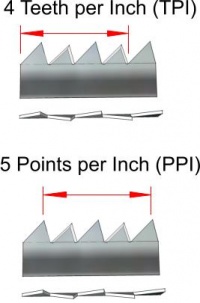Teeth per Inch: Difference between revisions
From DT Online
(Teeth per Inch) |
No edit summary |
||
| Line 13: | Line 13: | ||
</span> | </span> | ||
---- | ---- | ||
Alternatively blades can be measured in '''Points per Inch''', which is similar, but measured between teeth tips and so is always one number greater. '''[[Circular | Alternatively blades can be measured in '''Points per Inch''', which is similar, but measured between teeth tips and so is always one number greater. '''[[Circular Saw]]''' blades are measured by the total number of teeth around the circumference. | ||
Revision as of 12:23, 20 October 2014
The coarseness of saw blades is measured as the number of Teeth per Inch - or TPI. This is measured between the bottoms, or gullets, of the teeth. Typical values for commonly used saws are as follows:
* Ripsaw - 6 to 8 tpi * Crosscut saw - 8 to 10 tpi * Tenon saw - 10 to 14 tpi * Dovetail saw - 14 to 18 tpi * Coping saw - 16 to 24 tpi * Hacksaw - 18 to 24 tpi * Junior Hacksaw - 32 tpi (also 14 tpi woodcutting blade available)
Note: TPI can also be an abbreviation for Threads per Inch
Alternatively blades can be measured in Points per Inch, which is similar, but measured between teeth tips and so is always one number greater. Circular Saw blades are measured by the total number of teeth around the circumference.
